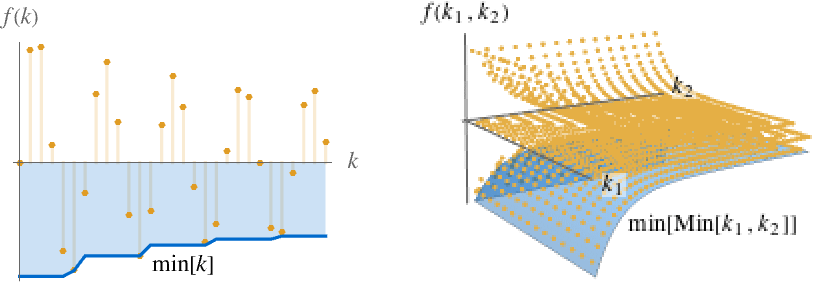DiscreteMinLimit
DiscreteMinLimit[f,k∞]
gives the min limit k∞f(k) of the sequence f as k tends to ∞ over the integers.
DiscreteMinLimit[f,{k1![]() ,…,kn
,…,kn![]() }]
}]
gives the nested min limit ![]() ⋯
⋯ ![]() f(k1,…,kn) over the integers.
f(k1,…,kn) over the integers.
DiscreteMinLimit[f,{k1,…,kn}{![]() ,…,
,…,![]() }]
}]
gives the multivariate min limit ![]() f(k1,…,kn) over the integers.
f(k1,…,kn) over the integers.
Details and Options



- DiscreteMinLimit is also known as limit inferior, infimum limit, liminf, lower limit and inner limit.
- DiscreteMinLimit computes the largest lower bound for the limit and is always defined for real-valued sequences. It is often used to give conditions of convergence and other asymptotic properties that do not rely on an actual limit to exist.
- DiscreteMinLimit[f,k∞] can be entered as
 f. A template
f. A template  can be entered as
can be entered as  dmlim
dmlim , and
, and  moves the cursor from the underscript to the body.
moves the cursor from the underscript to the body. - DiscreteMinLimit[f,{k1,…,kn}{
 ,…,
,…, }] can be entered as
}] can be entered as …
… f.
f. - The possible limit points
 are ±∞.
are ±∞. - The min limit is defined as a limit of the min envelope sequence min[ω]:
-
DiscreteMinLimit[f,k∞] DiscreteLimit[min[ω],ω∞] DiscreteMinLimit[f,{k1,…,kn}{∞,…,∞}] DiscreteLimit[min[ω],ω∞] - DiscreteMinLimit[f[k],k-∞] is equivalent to DiscreteMinLimit[f[-l],l∞] etc.
- The definition uses the min envelope min[ω]MinValue[{f[k],k≥ω∧k∈
 },k] for univariate f[k] and min[ω]MinValue[{f[k1,…,kn],k1≥ω∧⋯∧kn≥ω∧ki∈
},k] for univariate f[k] and min[ω]MinValue[{f[k1,…,kn],k1≥ω∧⋯∧kn≥ω∧ki∈ },{k1,…,kn}] for multivariate f[k1,…,kn]. The sequence min[ω] is monotone increasing as ω∞, so always has a limit, which may be ±∞.
},{k1,…,kn}] for multivariate f[k1,…,kn]. The sequence min[ω] is monotone increasing as ω∞, so always has a limit, which may be ±∞. - The illustration shows min[k] and min[Min[k1,k2]] in blue.
- DiscreteMinLimit returns unevaluated when the min limit cannot be found.
- The following options can be given:
-
Assumptions $Assumptions assumptions on parameters GenerateConditions Automatic whether to generate conditions on parameters Method Automatic method to use PerformanceGoal "Quality" aspects of performance to optimize - Possible settings for GenerateConditions include:
-
Automatic non-generic conditions only True all conditions False no conditions None return unevaluated if conditions are needed - Possible settings for PerformanceGoal include $PerformanceGoal, "Quality" and "Speed". With the "Quality" setting, DiscreteMinLimit typically solves more problems or produces simpler results, but it potentially uses more time and memory.

Examples
open allclose allBasic Examples (4)
Use ![]() dmlim
dmlim![]() to enter the template
to enter the template ![]() and
and ![]() to move from the underscript to the body:
to move from the underscript to the body:
TraditionalForm typesetting:
Scope (22)
Basic Uses (4)
Elementary Function Sequences (6)
Integer Function Sequences (3)
Sequences involving Factorial:
Sequence involving FactorialPower:
Compute the limit of a sequence involving Fibonacci:
Periodic Sequences (3)
Piecewise Function Sequences (2)
Options (6)
Assumptions (1)
GenerateConditions (3)
Return a result without stating conditions:
This result is only valid if x>1:
Return unevaluated if the results depend on the value of parameters:
By default, conditions are generated that return a unique result:
By default, conditions are not generated if only special values invalidate the result:
With GenerateConditions->True, even these non-generic conditions are reported:
Method (1)
PerformanceGoal (1)
DiscreteMinLimit computes limits involving sequences of arbitrarily large periods:
Use PerformanceGoal to avoid potentially expensive computations in such cases:
The Method option overrides PerformanceGoal:
Applications (3)
Compute the asymptotic minimum of a sequence:
Plot the sequence and the asymptotic minimum:
Verify that the following sequence does not have a limit:
Show that DiscreteMaxLimit and DiscreteMinLimit are not equal:
Confirm that the limit does not exist by using DiscreteLimit:
An algorithm runtime function ![]() is said to be "big-omega of
is said to be "big-omega of ![]() ", written
", written ![]() , if
, if ![]() :
:
Similarly, ![]() is said to be "big-theta of
is said to be "big-theta of ![]() ", written
", written ![]() if
if ![]() and
and ![]() :
:
It is possible for two functions to share neither relationship:
Hence, ![]() defines a reflexive partial order on the space of algorithm runtimes similar to
defines a reflexive partial order on the space of algorithm runtimes similar to ![]() :
:
If ![]() and
and ![]() , then
, then ![]() , which implies that
, which implies that ![]() is an equivalence relation:
is an equivalence relation:
Properties & Relations (11)
A real-valued function always has a (possibly infinite) min limit:
The corresponding limit may not exist:
If ![]() and
and ![]() have finite min limits, then
have finite min limits, then ![]() :
:
In this case, there is strict inequality:
Positive multiplicative constants can be moved outside a limit:
For a real-valued sequence, if DiscreteLimit exists, DiscreteMinLimit has the same value:
DiscreteMinLimit is less than or equal to DiscreteMaxLimit:
If DiscreteMinLimit equals DiscreteMaxLimit, the limit exists and equals their common value:
If the min limit is ![]() , then the max limit and thus the limit are also
, then the max limit and thus the limit are also ![]() :
:
DiscreteMinLimit can be computed as -DiscreteMaxLimit[-f,…]:
If the two max limits are equal—as in this example—then ![]() has a limit:
has a limit:
This is a generalization of the "squeezing" or "sandwich" theorem:
MinLimit is always less than or equal to DiscreteMinLimit:
Possible Issues (1)
DiscreteMinLimit is only defined for real-valued sequences:
Text
Wolfram Research (2017), DiscreteMinLimit, Wolfram Language function, https://reference.wolfram.com/language/ref/DiscreteMinLimit.html.
CMS
Wolfram Language. 2017. "DiscreteMinLimit." Wolfram Language & System Documentation Center. Wolfram Research. https://reference.wolfram.com/language/ref/DiscreteMinLimit.html.
APA
Wolfram Language. (2017). DiscreteMinLimit. Wolfram Language & System Documentation Center. Retrieved from https://reference.wolfram.com/language/ref/DiscreteMinLimit.html